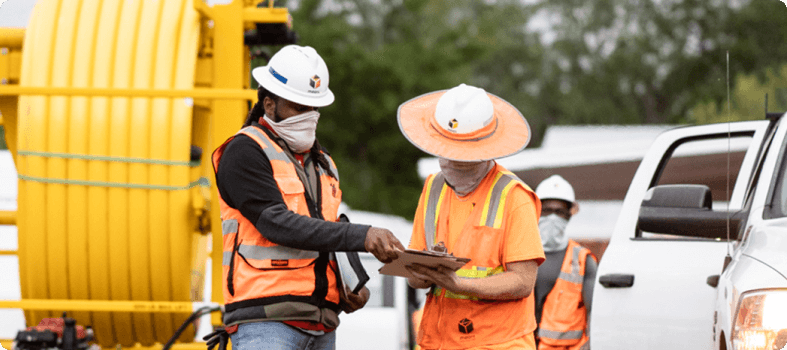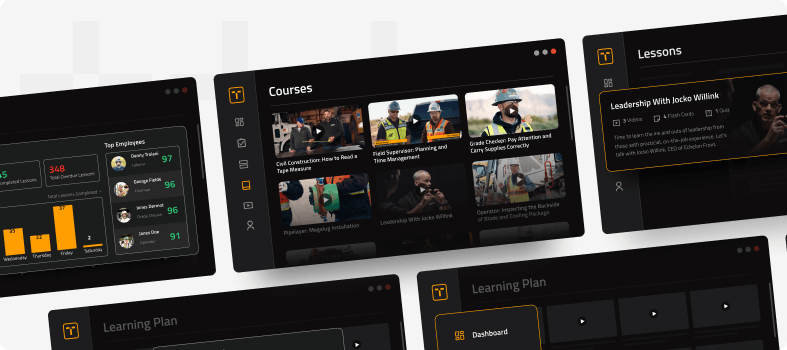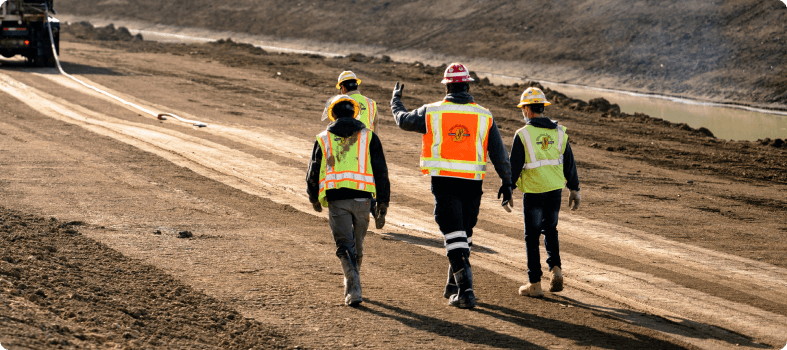Get Your Crew to Take Training Into Their Own Hands
Written by Megan Hamilton
December 2, 2022

You’ve heard the old saying, “You can lead a horse to water, but you can’t make him drink.”
Sometimes, that’s how training your crew feels. You put together a program, do everything you can to make it productive, and pay them for their time . . . but you’re just not getting the results you want.
Your crew members seem unengaged, unattentive, and just plain bored. They’re not taking responsibility for learning the material. And you. Just. Want. Them. To. Take. Initiative!
Here’s some news that might surprise you: so do they. In this article, we’ll talk about why your crew members really want to take initiative, what’s keeping them from doing it, and how you can help them take their training into their own hands.
Let’s dig in.
What do crew members really want?
Construction workers want four types of career growth, ranked in this order:
- Financial, like fair base pay and bonuses
- Personal, like responsibility and job challenge
- Professional, like training and promotions
- Social, like flex time and work-life balance1
Most of that growth stems from your crew members taking initiative.
You’ll give them more responsibility when they step up to the work already on their plates. You’ll promote them when they prove they have what it takes to lead. You’ll give them more challenging jobs when they learn the skills to do the work safely.
But their idea of taking initiative and yours might be different.
Taking initiative on the jobsite versus in training

Training is the key to unlocking growth opportunities. Crew members need training, so they have the skills to take on that tough job, leadership role, or new responsibility.
But many crew members don’t see it that way. They think they can “earn” their way to growth by showing up and getting the job done. They may go the extra mile on the jobsite but not in the classroom.
Your crew is taking initiative where they think it counts . . . they don’t think training counts. So they show up, but they don’t pay attention. They listen but don’t participate. They seem to “get it” in the classroom—only to get out in the field and forget what they learned.
The good news is that your crew members want to learn and are willing to take initiative. So if they’re not doing that, then one of two things is happening.
Either they don’t realize how important training is, or something about the training program prevents them from engaging effectively. (Or both.)
So, how do you get them to take their training into their own hands?
Make it important
If you’re dealing with the first problem, your crew members just don’t think the training you offer is all that important. They’re unclear on why it matters.
So, tell them.
Yep, that’s our best advice—tell them. People are hardwired to invest their energy into things they care about and take it easy on the things they don’t. You shouldn’t get mad at people for not investing effort in training if you haven’t communicated why that training is important.
To unearth the “why,” answer these questions:
- How will it benefit my crew members outside of work?
- How will this training give them the career growth they want?
- How does it fit into our company mission—the “why” behind what we do as a team?
Then you can turn those answers into statements that you tell your team, like:
- This safety training is super important because we’re dealing with hazardous materials, and we want you to get home safe to your family.
- If you want to be a foreman or field supervisor one day, you must do this leadership training.
- One of our core values is “no shortcuts.” This skill training will teach you how to do the work quickly and properly.
Make it easy
If you’re dealing with the second problem, something about your training program is keeping crew members from fully engaging. Your goal is to remove as many roadblocks as you can so people want to do their training.
Some common roadblocks include:
- It’s boring.
- It doesn’t apply to me.
- It’s too hard to understand.
- I can’t get to the material.
- It takes way too long.
- I can’t remember all that stuff.
Those are all legitimate reasons crew members may struggle to engage in or retain their training.
When you try to make training easy, you’re looking for a fun, relevant, easy-to-use, and quick program. It should be simple enough that crew members can easily digest and retain the information—but not so simple that it insults their intelligence.
Make it fun

Contrary to popular belief, crew members aren’t tuning out because they have short attention spans.2 They’re tuning out because they’re bored.
People are most likely to engage in training when they have a good time doing it. One study found that delivery is more important for engagement than training format.3 That means even a PowerPoint presentation can be fun if delivered well.
But what counts as a “fun” delivery?
First of all, fun isn’t goofy. You don’t want some cheesy, kiddie animations for a roomful of adults. But it shouldn’t be a snooze fest, either.
One of the best ways to make training fun is to use modern, professional videos and images that show real people on real jobsites.
Many of your crew members work in the Dirt World because they think it’s cool (and they’re right). So show them what made them want to work in the industry. Show them the tools and machines they use every day.
You’d be surprised how much your crew engages when they can imagine themselves in the training scenarios.
You should also look for training content from down-to-earth experts. They’ll have the technical knowledge your crew needs, but they’ll deliver it in a way that makes them feel like they’re learning from a trusted coworker—not somebody who’s talking down to them.
And if those experts anything like us here at BuildWitt, they’ll have a sense of humor. A good, safe-for-work joke can go a long way.
Make it relevant

There’s nothing worse than sitting through a one-hour lecture on something that has nothing to do with your job . . . except maybe sitting through a two-hour lecture on something that has nothing to do with your job.
If it’s not relevant, your crew won’t do it. Oh sure, they may pretend to watch the training slides, but they’re thinking about sandwiches or their kid’s sports practice.
Your training program needs to relate directly to what your crew members do on the jobsite. Within the first five to ten seconds, they should be able to tell that this material is important to their role. They should be able to see how this training will keep them safer, help them do their jobs better, or help them move up within the company.
Role-specific training comes in handy here. You can assign machine walkarounds lessons to operators and trench boxes to pipelayers. Everybody gets what they need—without having to sit through all the other stuff that doesn’t apply to them.
Make it accessible

When you’re talking about training, accessibility means two things. One, can your crews quickly and easily access the material? Two, can they understand that material?
Besides the operation and maintenance manuals you keep on your machines, your crew shouldn’t have to carry around a big, fat training binder. You want something they can access anywhere, any time—like an app on their phones. It should just take the push of a button to have their training assignments loaded and ready to go.
Those assignments should also be easy to understand. Maybe you need some images to help illustrate a technical concept. Maybe you need training material that uses plain words instead of sounding like a college course on astrophysics. Maybe you need Spanish-language content for some of your crew members. Maybe you need specialized content for employees who have hearing or vision impairments.
Whatever the case, you want a program that makes training make sense for your people.
Make it memorable
One of the most common complaints about training is that it’s too long. That’s especially true if you have a “hit-and-run” training program—where you train hard on the occasional rainy day, then don’t train again until the weather turns bad.
Several studies have found that training is most effective when learners go through short sessions that are spaced apart. You may find this research helpful:
- People in the early stages of training learn fastest with short sessions (around eight minutes).
- People in the later stages of training learn fastest when sessions are less than one hour long.
- People with four one-hour training sessions didn’t do any better than those with a single one-hour session.
- People who took a single one-hour training session continued to improve in their skills after training, but people from the four-hour session group did not.4
In other words, crew members learn material quicker during short training sessions. And they’re more likely to keep absorbing that material after the training ends.5 So shorter sessions help make training more memorable.
That’s why microlearning is ideal for construction and extraction training. Microlearning uses brief training content, like videos, images, or short stories—but each lesson only takes a few minutes to complete.
Training is also more memorable when repeated—especially for important safety skills like CPR. One study found that people who trained once a month were nearly four times more likely to perform CPR with excellent proficiency than someone who trained once a year.6 Reviewing material for ten minutes or less every week for a month also increases retention.7
Additionally, training assessments should be spaced apart to improve retention. Testing life-saving skills three months after training was more effective than testing them immediately after training.8
So to recap, memorable training lets crew members do short lessons, repeat training sessions, and take well-timed assessments.
And if you’re creating your own training talk, follow Dave Nihill’s advice. He’s the founder of FunnyBizz, a community and conference series that’s out to make content fun. Nihill encourages business leaders to remember the old comic’s saying: “A tight five is better than a sloppy 15.”9 In other words, keep it short and deliver your best—you can always use the extra time for Q&A at the end.
Make it theirs
Okay, you’ve told your team why training is important and gave them a training program that sets them up for success. Now it’s time to let go and let them take their training into their own hands.
First, make it everybody’s responsibility to do their training—and everybody’s problem if they don’t.
That doesn’t isn’t necessarily mean punishing your crew for not watching a training video. Instead, help them understand why that video is important so they want to watch it. And help them understand the consequences—like physical injury or time-consuming rework—if they don’t.
You can also motivate crew members to complete training with rewards. This works especially well if you make it a competition between crews because the members of each crew will hold each other accountable to help the whole group succeed.
Here’s another pro tip from Jocko: You and your leaders must model what taking ownership looks like. Take extreme ownership of your own training and role—and make sure your crew members see it. But don’t fake it. This has got to be the real McCoy if it’s going to work.
When extreme ownership is the norm at your company, that positive peer pressure will help keep your crew members and your leadership team on the straight and narrow.
Remember, many of your workers may be new to the Dirt World, so they'll follow the example leadership sets. Others may have come from companies that don’t do things the way you do—companies where training may have been just a box to check but not something to truly practice in the field.
That’s why leaders should know what their crews are learning—or even better, learn it themselves. Then they can uphold it in the field.
Crew members need to see leaders follow what the training says. They need to know that there’s no double standard—that no one will say, “Yeah, that’s what the training said, but here’s how we do it onsite.”
Once they trust leaders to play by the book, they’ll start to get on board. Pretty soon, you’ll have crew members holding each other and even their foremen accountable.
The training program we recommend

By now, you’re expecting a lot from a training program—and you should be! That said, there is no single perfect training solution. They’ve all got pros and cons, so it’s about finding the one that works for you.
You can get practical tips to improve your current training program from our new guide to training for retention and recruitment. Plus, it'll teach you how to measure your ROI on training, so you know whether any changes you make are working.
Another great place to start is by exploring BuildWitt Training. This simple, easy-to-use app lets you put training in the palm of your crew members’ hands. They’ll get access to 600+ microlearning videos that cover topics from leadership and career growth to safety and skills they’ll need on the job.
Best of all, these videos are made by people in the Dirt World for people in the Dirt World. They know what your crew members go through every day—and what they need to succeed.














